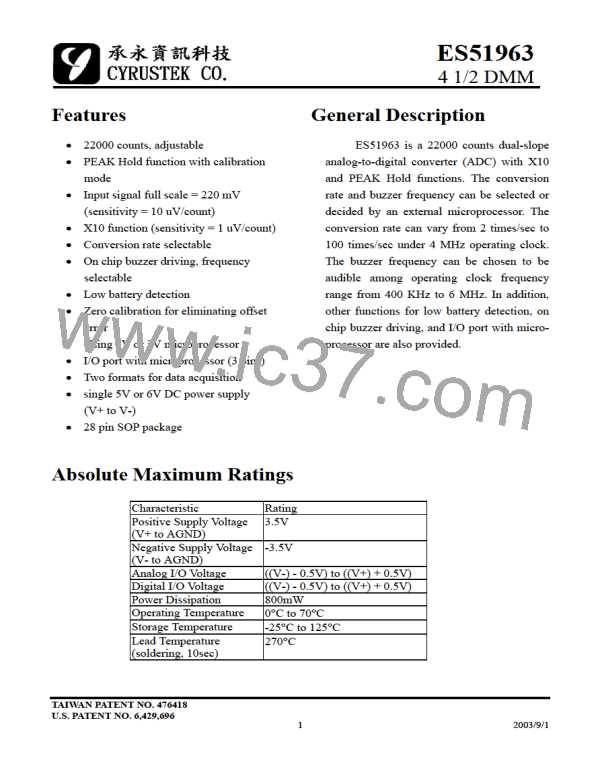ES51963
4 1/2 DMM
For example, if the CR is 10 times/sec, the maximum DINT time is 44 ms, and the
resolution will be 22000 (11000) counts based on a 500 (250) kHz clock.
mode 2: ES51963 receives controlled status from microprocessor.
force A/D entering into AZ phase
(V-)+2.1V
(V-)+0.8V
EOC (O)
(520~1020)Tosc1
(1040~4096)Tosc1
T=(32~512)Tosc1
>4Tosc1
(V-)+2.1V
(V-)+0.8V
SCLK (I)
START
END
(0~256)Tosc1
512Tosc1
(2~1024)Tosc1
(2~1024)Tosc1
2C
uP
2E
(V-)+2.1V
(V-)+0.8V
STATUS (I/O) A/D
A/D
status
uP
520Tosc1
(4~256)Tosc1
O: output to microprocessor
I: input into IC
2D
2F
I/O: exchange between I and O
2A
2B
Note: 1. The START bit:
After time 2A, the EOC's state is forced to low (V-) and ES51963 enter
into AZ phase. And at the same time, STATUS is changed from output pin to
input pin with a 3 uA pull low current provided by ES51963 internally. Then
microprocessor can send control status to STATUS. It is suggested that micro-
processor begins to drive STATUS between 2B and 2C.
2. The END bit:
The microprocessor stopped driving STATUS between 2D and 2E, and
ES51963 will begin to drive STATUS after 2F.
3. Serial Data Format (STATUS):
In mode 2, only the status bits X10, PEAK, PCAL, ZERO, C0, C1, C2, B0,
B1, B2, FORMAT and TEST are meaningful. However the microprocessor still
needs to send the complete word of status (16 bits) although ES51963 will
discard the other bits.
4. The detail timing between SCLK and STATUS is as follow:
(32~512)Tosc1 with 40~60 % duty cycle
(V-) + 2.1V
(V-) + 0.8V
SCLK
(V-) + 2.1V
(V-) + 0.8V
STATUS
S0
S1
S2
S14 S15
12
2003/9/1

 CYRUSTEK [ Cyrustek corporation ]
CYRUSTEK [ Cyrustek corporation ]